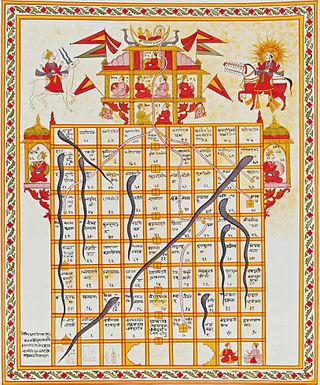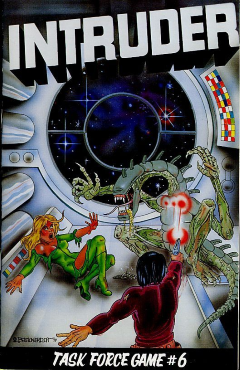
Doctor Who: The Game of Time & Space is a board game published by Games Workshop in 1980 that is based on the long-running British television series Doctor Who .

Doctor Who: The Game of Time & Space is a board game published by Games Workshop in 1980 that is based on the long-running British television series Doctor Who .
The planet Gallifrey, home of the Time Lords, is expecting an attack, and the only defence will be the Key of Chronos. However, the Key has been taken apart and the pieces scattered across time and space. Players take on the roles of various iterations of The Doctor striving to search for pieces and reassemble the Key. [1]
The game contains: [2]
Each turn, the active player can choose two of three activities: move, search, fight. [3]
Each player can move their token two squares in any direction. If a token reaches one of the space/time warp squares at the edge of the board, the token can be teleported to the far side of the board onto another space/time warp square of the matching color. [3]
When returning to Gallifrey at the end of the game, a token cannot move two squares directly onto Gallifrey. The token must be moved adjacent to Gallifrey on one turn, and then can move to Gallifrey on the next turn. [3]
Searching a planet involves turning over the alien counter for everyone to see, and secretly examing the Key part — which may be a Key part the player needs, or a Key part needed by another player, or a blank. The Item counter is left untouched. [3]
In order to collect the Item and the Key part, the player must destroy the alien. If the Doctor decides the alien is too strong and leaves the planet without combat, then the Key part is turned over for all players to see. Any Doctor arriving on the planet can fight the alien for the Key part and the Item. [3]
Each alien counter has a strength number, which the alien must equal or exceed on the 12-sided die in order to hit the Doctor. The Doctor also has a strength number, but this may be modified by an Assistant or carried Items. [3]
The first player to collect the six Key parts described in their Key Missions and successfully return to Gallifrey is the winner. [3]
In the April 1981 edition of The Space Gamer (No. 38) Forrest Johnson was not overly impressed, believing the target audience was younger players rather than adult gamers. He concluded, "Recommended to die-hard Dr. Who fans or to those who are beginning to find Candyland a little dull." [1]
In Issue 35 of Phoenix (January–February 1982), Paul King thought it was an enjoyable game but noted "It is aimed at the younger end of the market without a doubt, and is very successful in this aim." He concluded, "Full marks to Games Workshop for this design at least, it lives up to expectations and provides a fun game which can be played in less than two hours with six players." [3]

Ludo is a strategy-based board game for two to four players, in which the players race their four tokens from start to finish according to the rolls of a single die. Like other cross and circle games, Ludo originated from the Indian game Pachisi. The game and its variations are popular in many countries and under various names.

Snakes and ladders is a board game for two or more players regarded today as a worldwide classic. The game originated in ancient India invented by saint Dnyaneshwar as Moksha Patam, and was brought to the United Kingdom in the 1890s. It is played on a game board with numbered, gridded squares. A number of "ladders" and "snakes" are pictured on the board, each connecting two specific board squares. The object of the game is to navigate one's game piece, according to die rolls, from the start to the finish, helped by climbing ladders but hindered by falling down snakes.

Nine men's morris is a strategy board game for two players dating at least to the Roman Empire. The game is also known as nine-man morris, mill, mills, the mill game, merels, merrills, merelles, marelles, morelles, and ninepenny marl in English. In North America, the game has also been called cowboy checkers, and its board is sometimes printed on the back of checkerboards. Nine men's morris is a solved game, that is, a game whose optimal strategy has been calculated. It has been shown that with perfect play from both players, the game results in a draw.

Kensington is an abstract strategy board game devised by Brian Taylor and Peter Forbes in 1979, named after London's Kensington Gardens, which contains the mosaic upon which the gameboard is patterned. It is played on a geometrical board based on the rhombitrihexagonal tiling pattern. The objective of the game is to capture a hexagon by occupying the six surrounding vertices. The game maintains an elegant simplicity while still allowing for astonishingly complex strategy. The placing and movement of tokens have been compared to nine men's morris.

The 3-D Battles of WorldRunner, originally released in Japan as Tobidase Daisakusen, is a 1987 third-person rail shooter platform video game developed and published by Square for the Family Computer Disk System. It was later ported to cartridge format and published by Acclaim for the Nintendo Entertainment System.

Cosmic Encounter is a science fiction–themed strategy board game designed by "Future Pastimes" and originally published by Eon Games in 1977. In it, each player takes the role of a particular alien species, each with a unique power to bend or break one of the rules of the game, trying to establish control over the universe. The game was inducted into the Academy of Adventure Gaming Arts & Design Adventure Gaming Hall of Fame in 1997.
In tabletop games and video games, game mechanics specify how a game works for the players. Game mechanics include the rules or ludemes that govern and guide player actions, as well as the game's response to them. A rule is an instruction on how to play, while a ludeme is an element of play, such as the L-shaped move of the knight in chess. The interplay of various mechanics determines the game's complexity and how the players interact with the game. All games use game mechanics; however, different theories disagree about their degree of importance to a game. The process and study of game design includes efforts to develop game mechanics that engage players.

Space Crusade is an adventure board game produced by Milton Bradley together with Games Workshop and was first made in 1990. It was produced in the UK and available in some other countries including Finland, Ireland, France, Spain, Denmark, Australia, Hellas and New Zealand. In Germany, Italy, Belgium and the Netherlands, it is known as Star Quest.

Ultra Marines is one of a series of 4 "introductory" board games released by Games Workshop in 1991. Set in the Warhammer 40,000 universe, it is effectively a 'scaled-down' version of Space Hulk and Tyranid Attack, using plastic Marine Scouts from the Ultramarines, Space Wolves, Dark Angels and Blood Angels chapters. Other components include event cards, a simple ruleset, as well as corridor and room tiles from the game Space Hulk.

The Mystery of Time and Space is a popular online graphic adventure game created by Jan Albartus (LOGAN). The game was produced using Macromedia Flash and was an early influential example of the escape the room genre. There are 20 levels of varying length, some consisting of a single room and others consisting of a large network of rooms. Though advertised as a constant work-in-progress with "new levels coming soon," MOTAS has not been updated since May 2008.

Triplanetary is a science fiction board wargame originally published by Game Designers' Workshop in 1973. The game is a simulation of space ship travel and combat within the Solar System in the early 21st Century.
The long-running British science fiction television series Doctor Who has since its beginnings in 1963 generated many hundreds of products related to the show, from toys and games to picture cards and postage stamps. This article is not an exhaustive list of merchandise but attempts to present a flavour of the type of material that has been produced. This entry mainly concentrates on "official" spin-offs, that is to say, material sanctioned by the British Broadcasting Corporation, which produces the series.

Arkham Horror is a cooperative adventure board game designed by Richard Launius, originally published in 1987 by Chaosium. The game is based on Chaosium's roleplaying game Call of Cthulhu, which is set in the Cthulhu Mythos of H. P. Lovecraft and other horror writers. The game's second edition was released by Fantasy Flight Games in 2005, with a third edition in 2018.

Dune is a strategy board game set in Frank Herbert's Dune universe, published by Avalon Hill in 1979. The game was designed by Bill Eberle, Jack Kittredge and Peter Olotka. After many years out of print, the game was reissued by Gale Force Nine in 2019 in advance of the 2021 Dune film adaptation.

Starfarers of Catan is a multiplayer board game loosely based on the Settlers of Catan series of games. It was created by Klaus Teuber as an official spin-off and is distributed by Kosmos in German and Mayfair Games in English.

RoboRally, also stylized as Robo Rally, is a board game for 2–8 players designed by Richard Garfield and published by Wizards of the Coast (WotC) in 1994. Various expansions and revisions have been published by WotC, Avalon Hill, and Renegade Games.
This glossary of board games explains commonly used terms in board games, in alphabetical order. For a list of board games, see List of board games; for terms specific to chess, see Glossary of chess; for terms specific to chess problems, see Glossary of chess problems.

Intruder is a solitaire science fiction microgame published in 1980 by Task Force Games in which a rapidly maturing alien roams a space station, ambushing and killing crew members.
Hexagony is an abstract strategy board game for 2 to 6 players that was published as Bin'Fa by Taoist Arts Inc. in 1977, as Hexagony by Avalon Hill in 1980, and later re-released in a slightly modified form by Kenterprises as Bin'Fa.

WorldKiller: The Game of Planetary Assault is a science fiction board wargame published by Simulations Publications Inc. (SPI) in 1980 that simulates humans in the far future defending a planet against an alien attack.